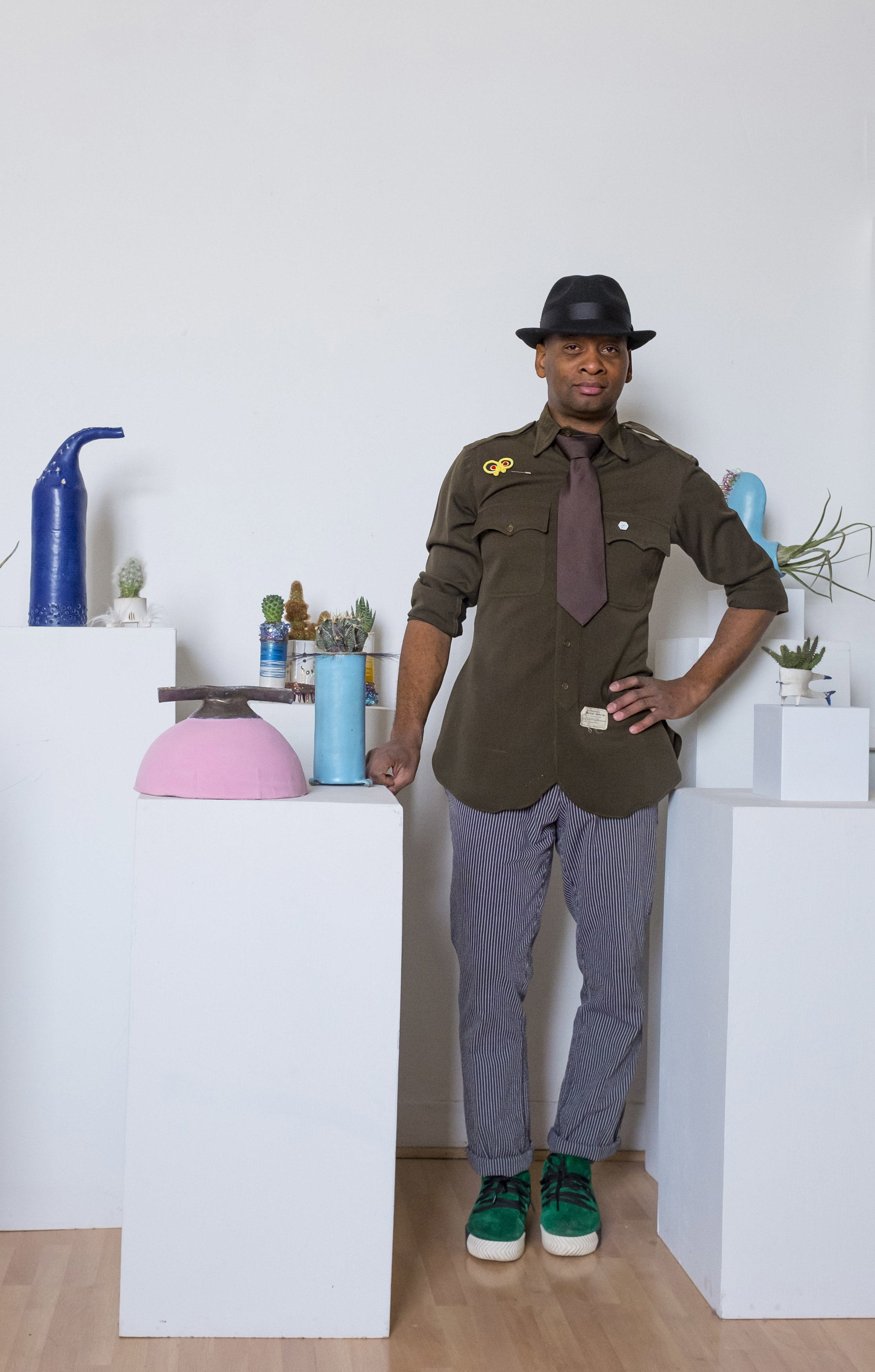
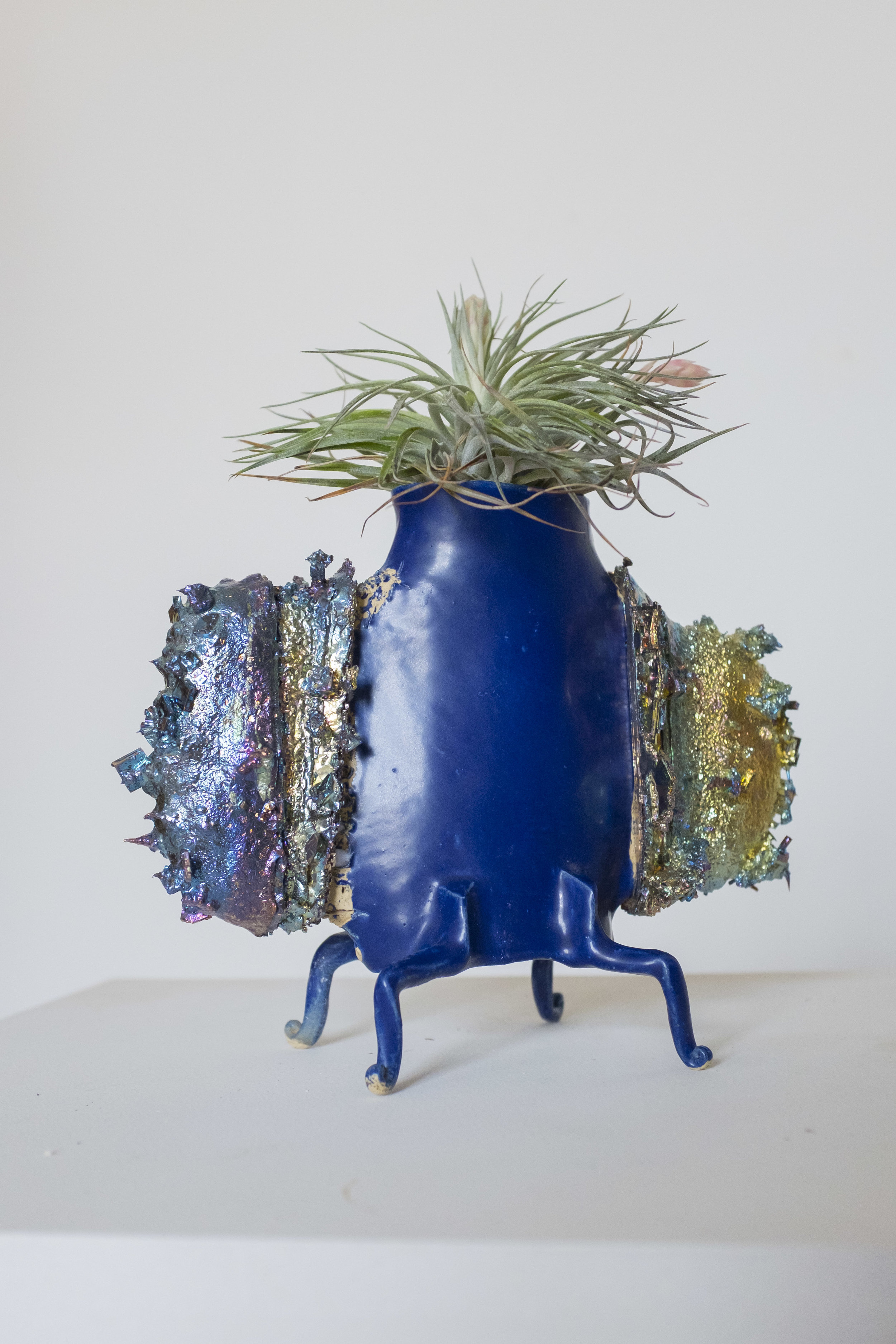
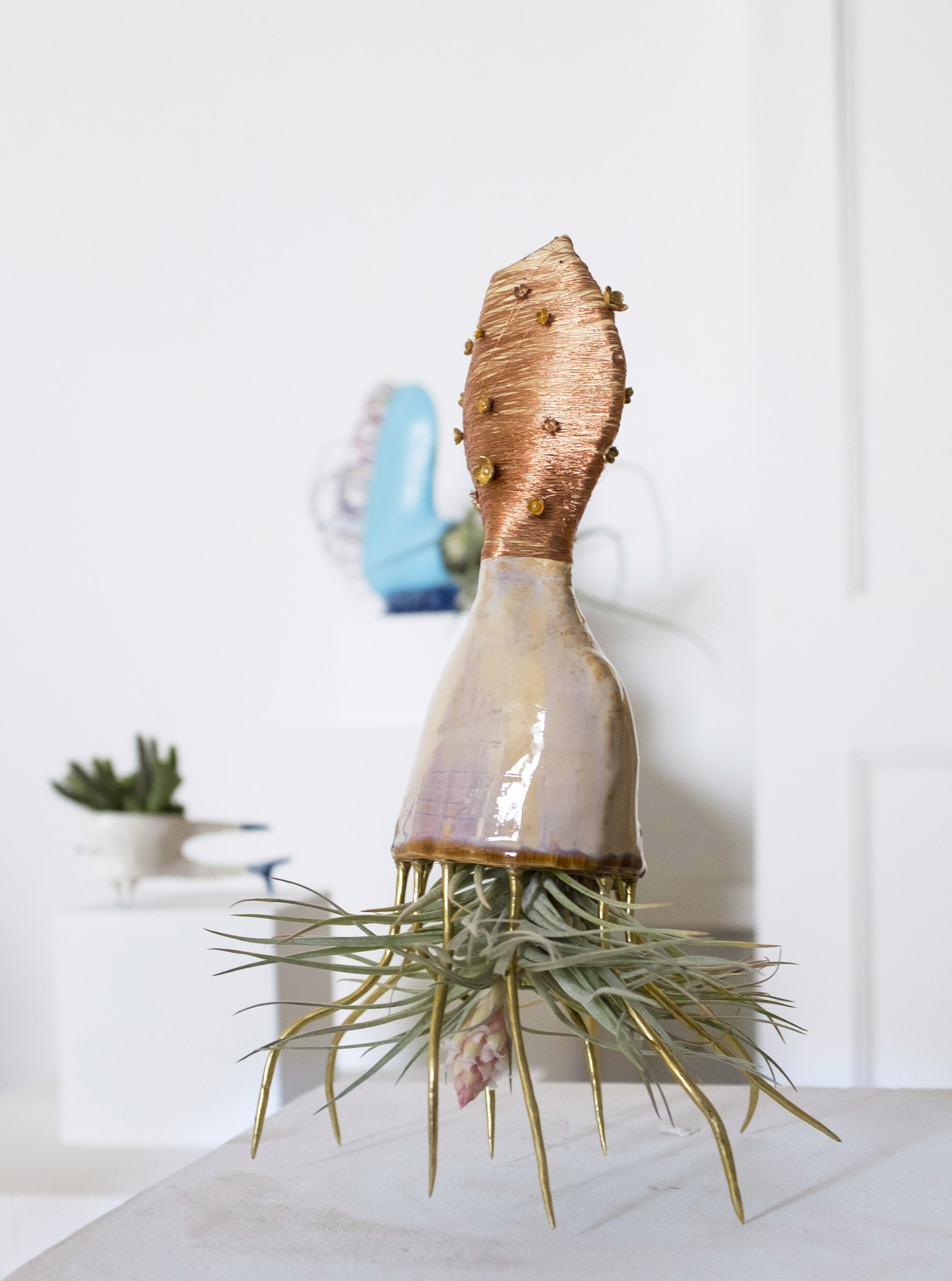
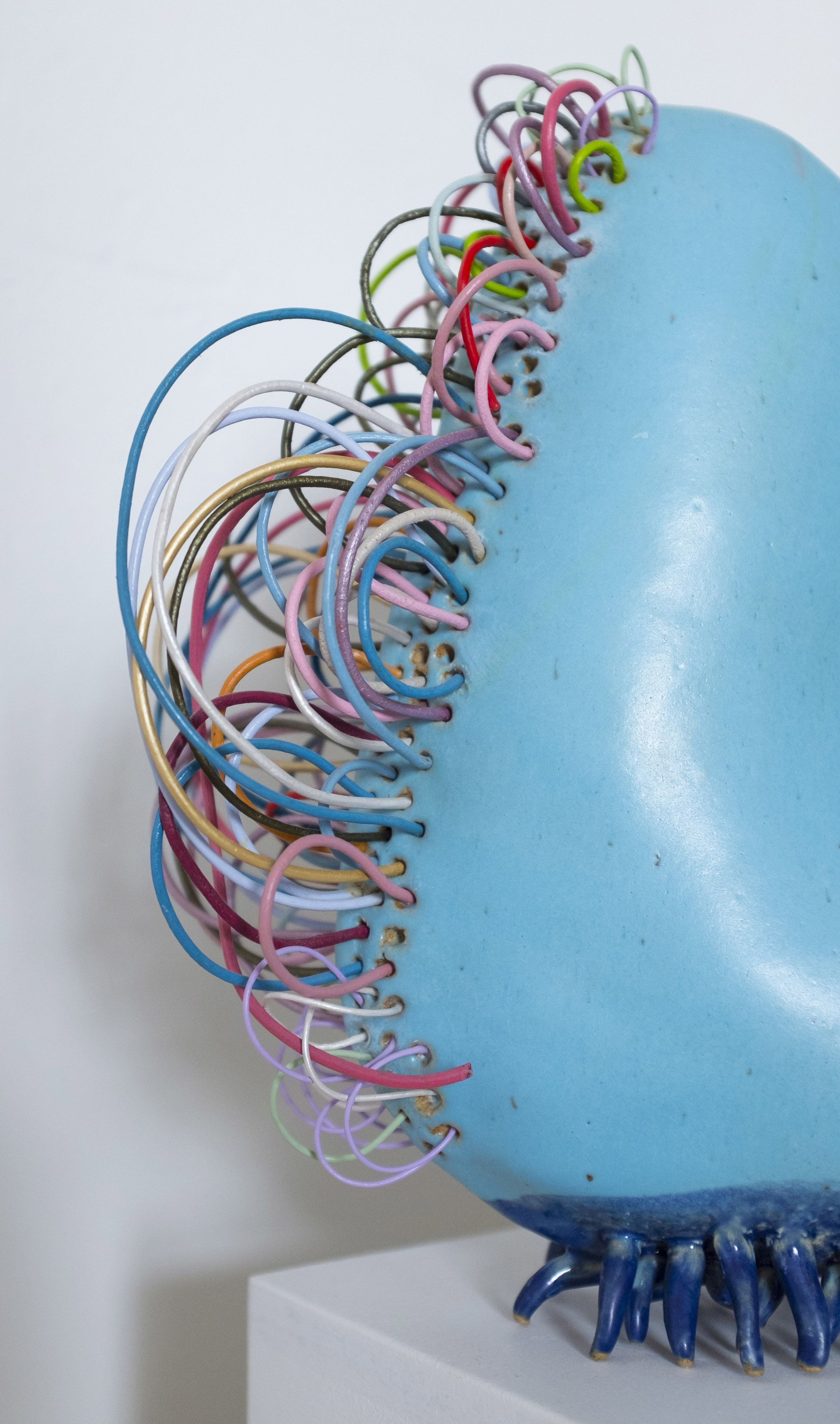
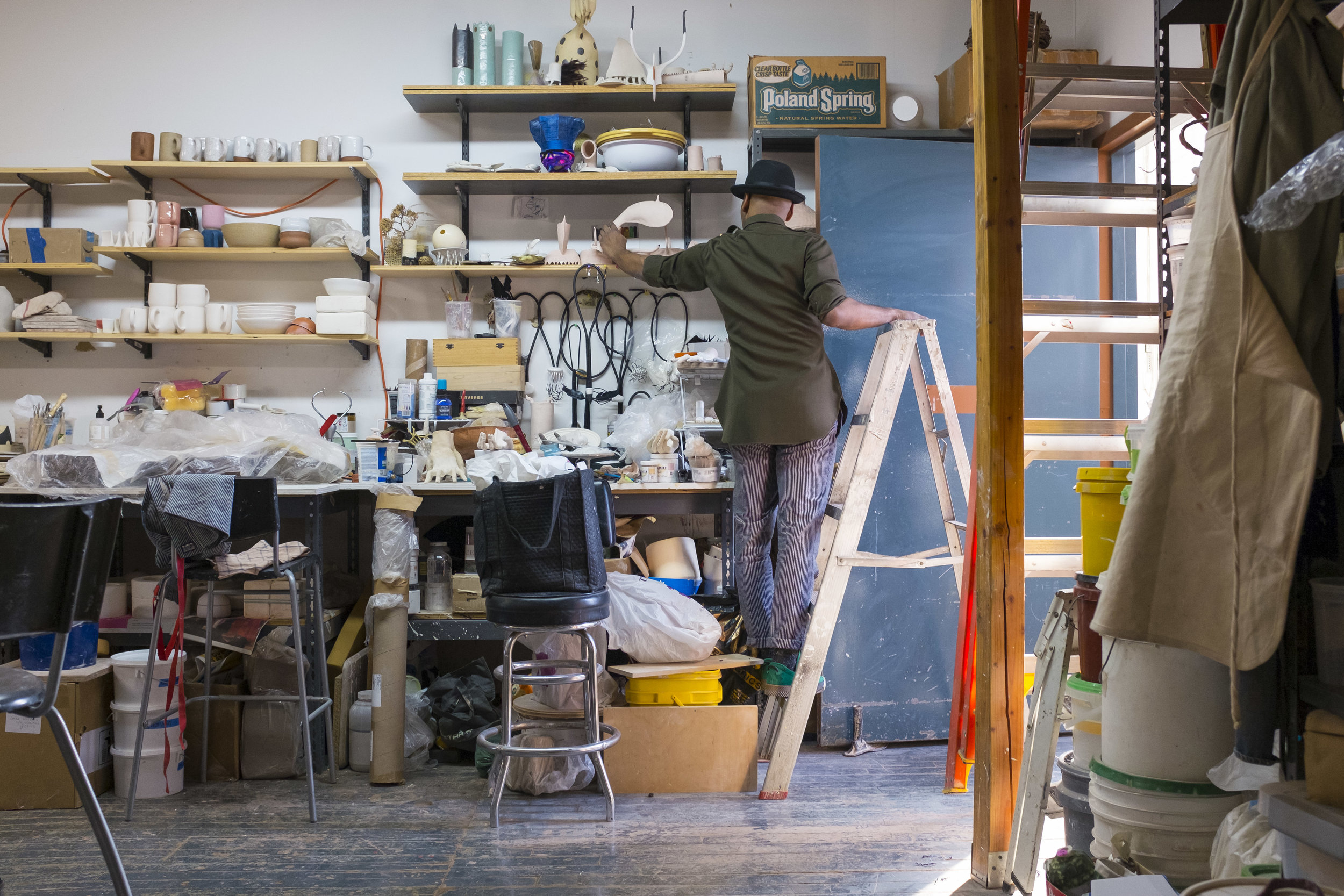
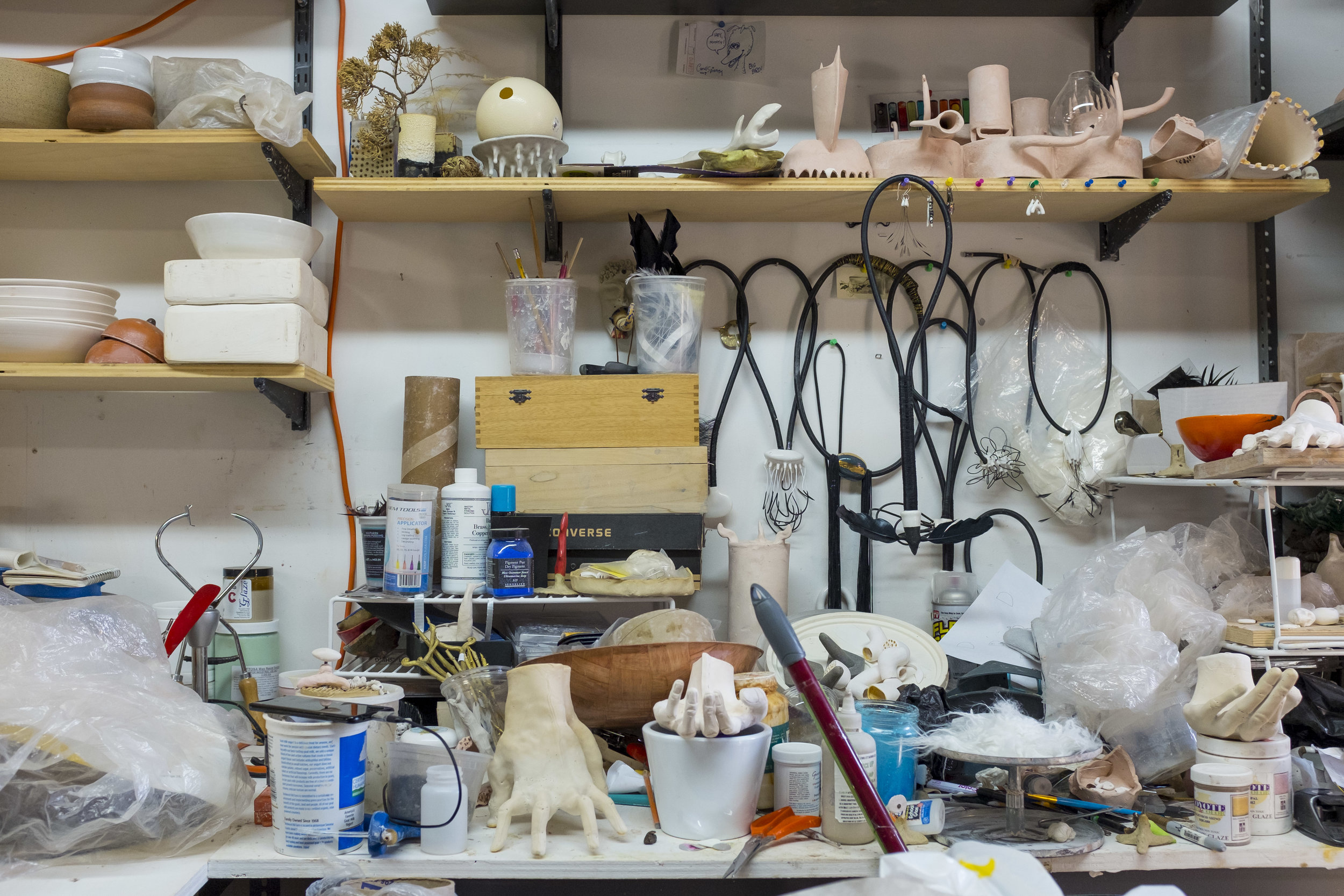
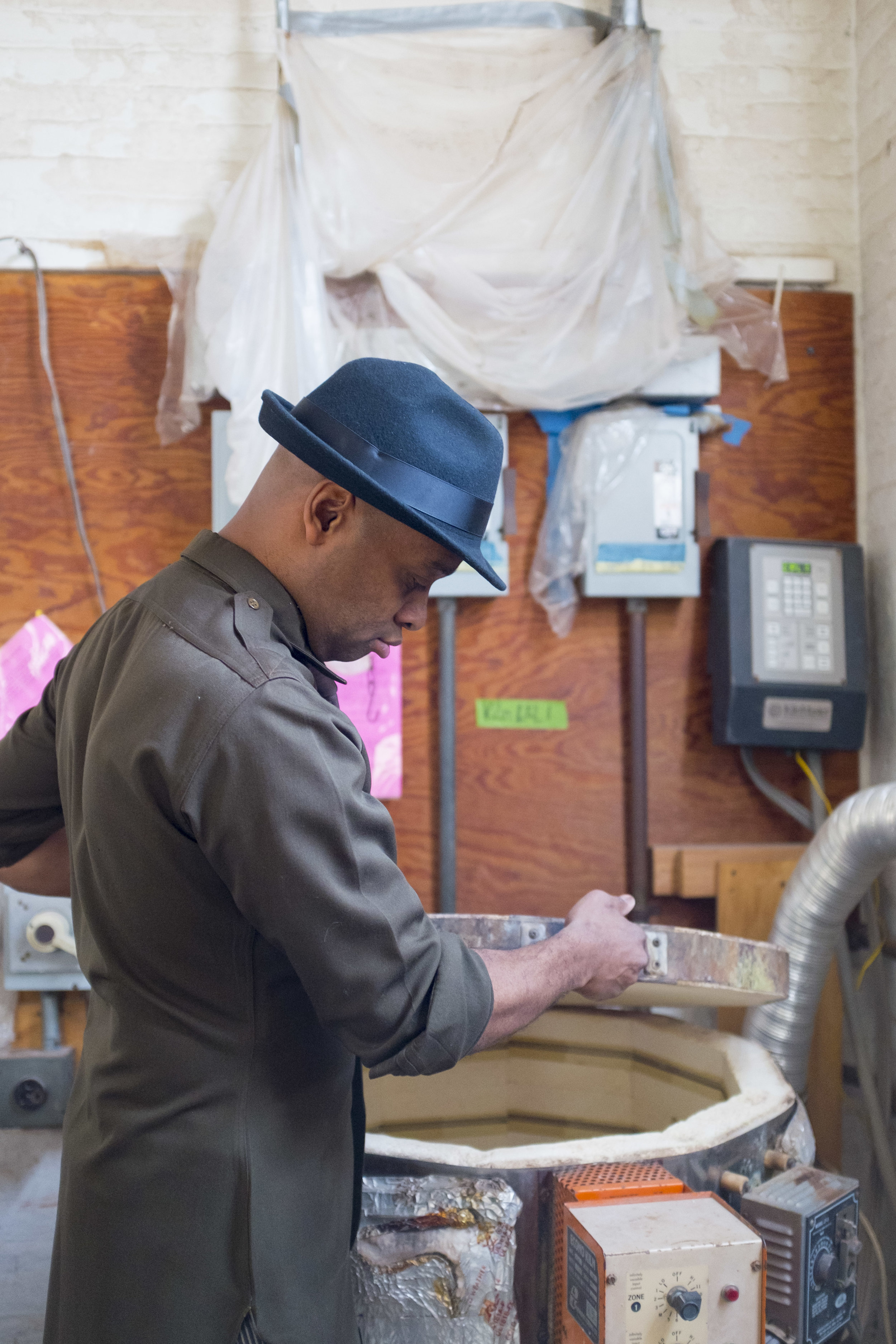
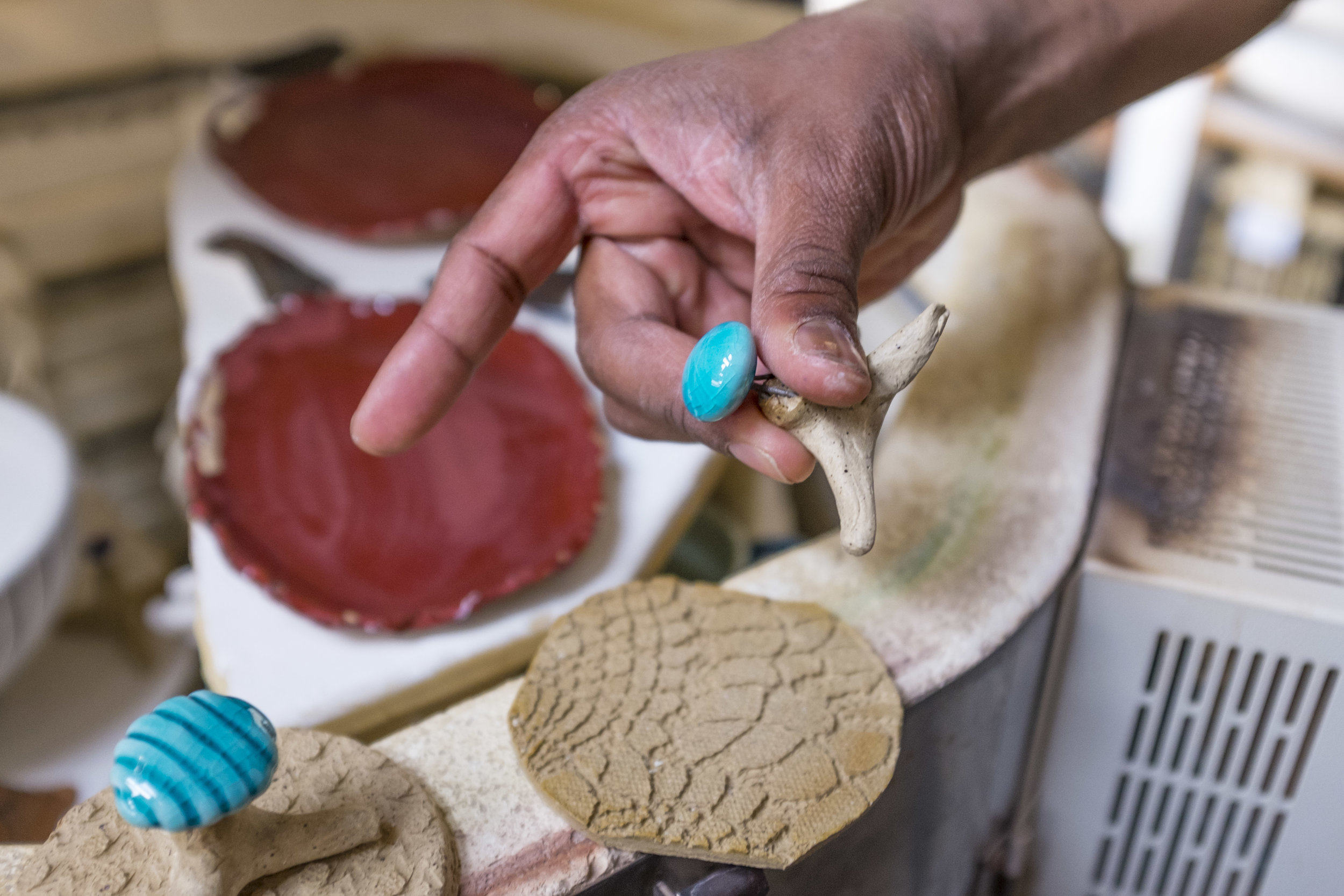
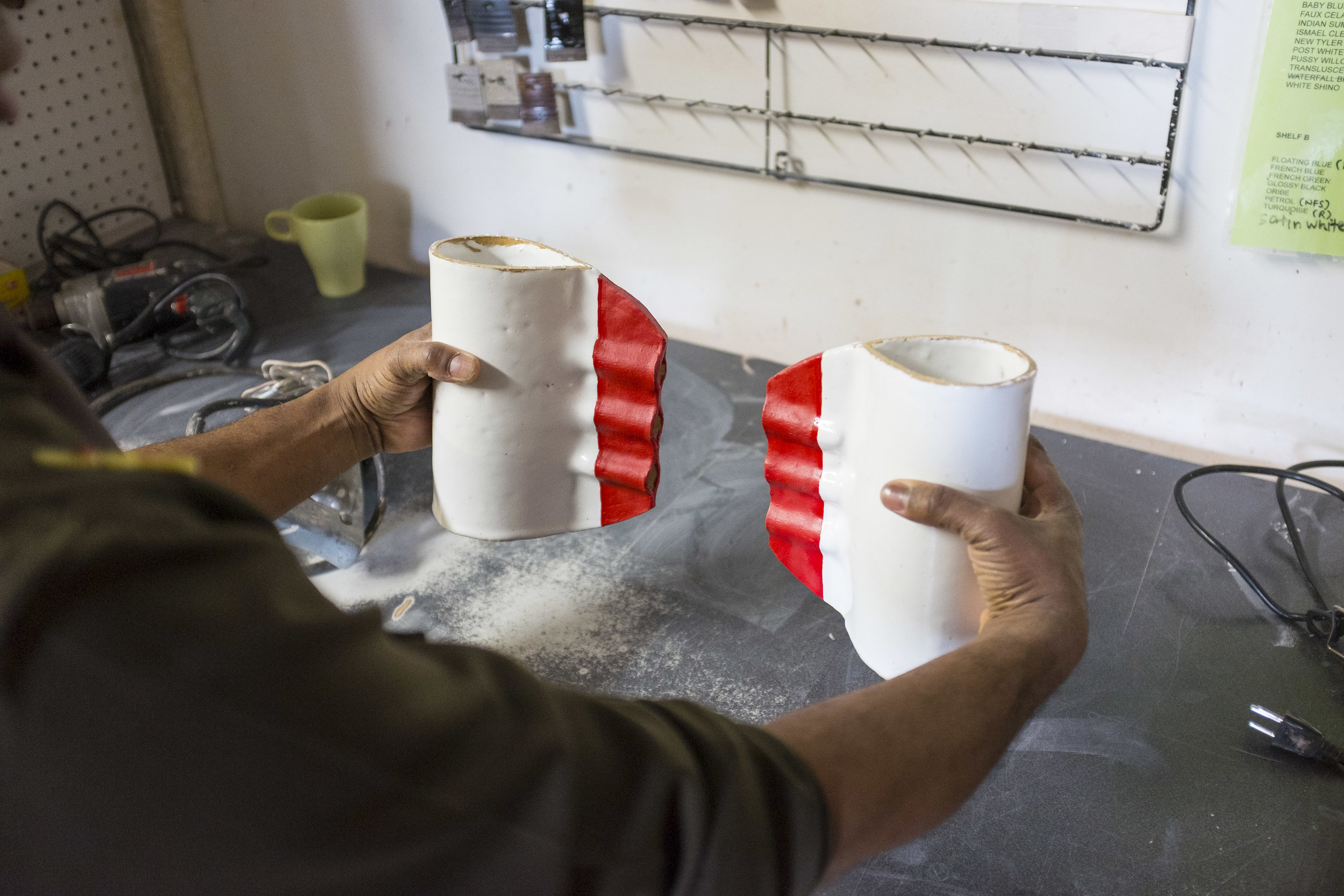
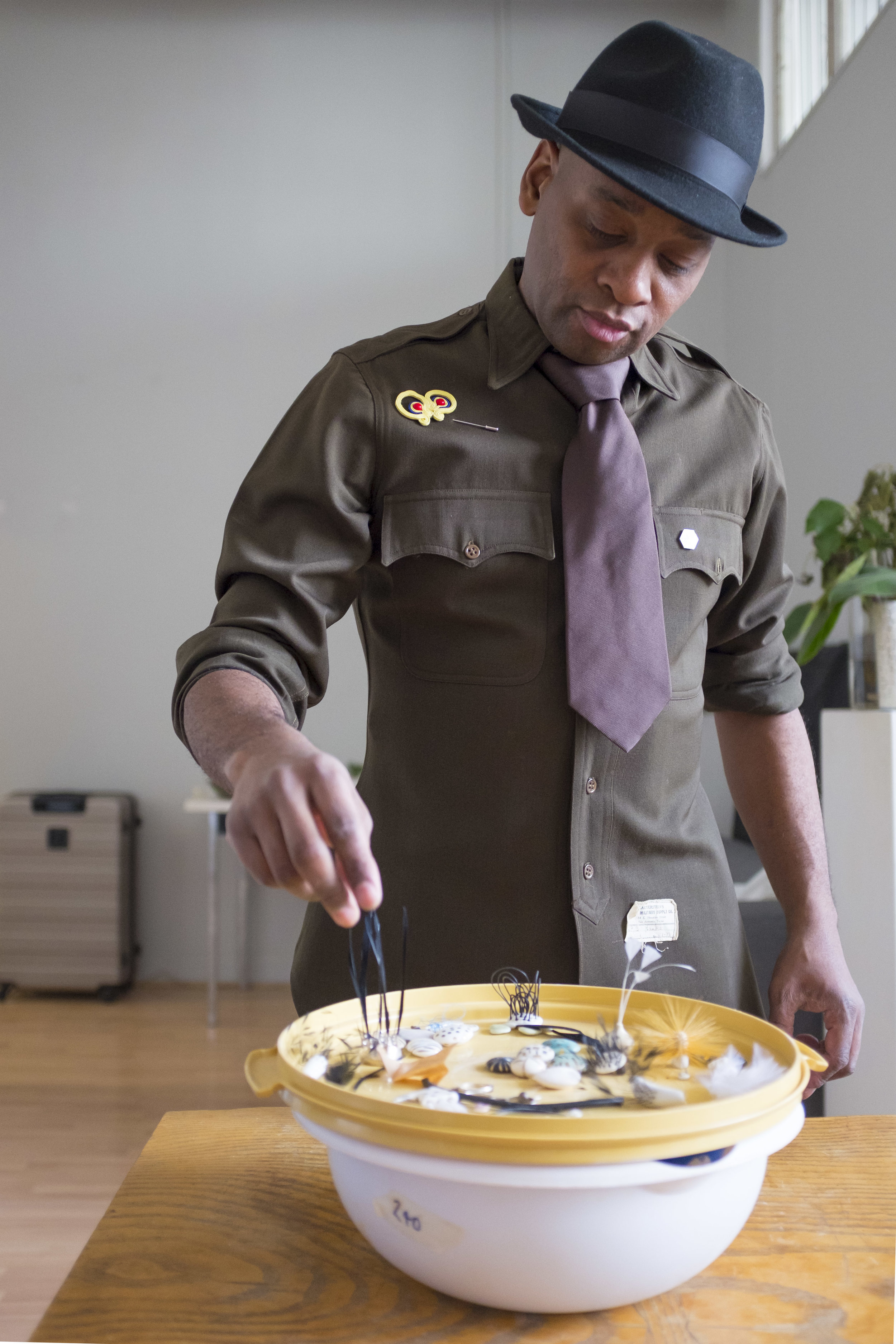
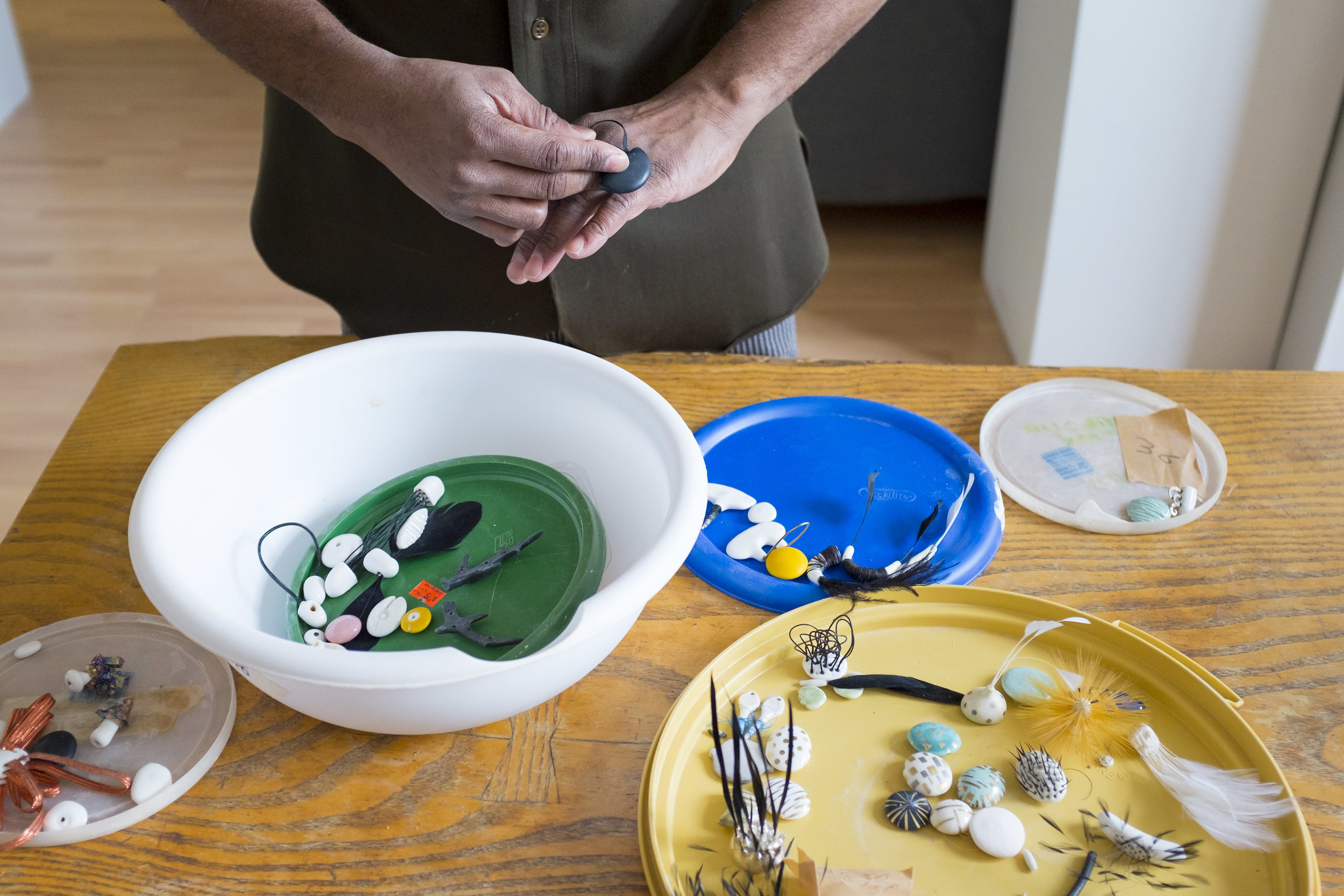
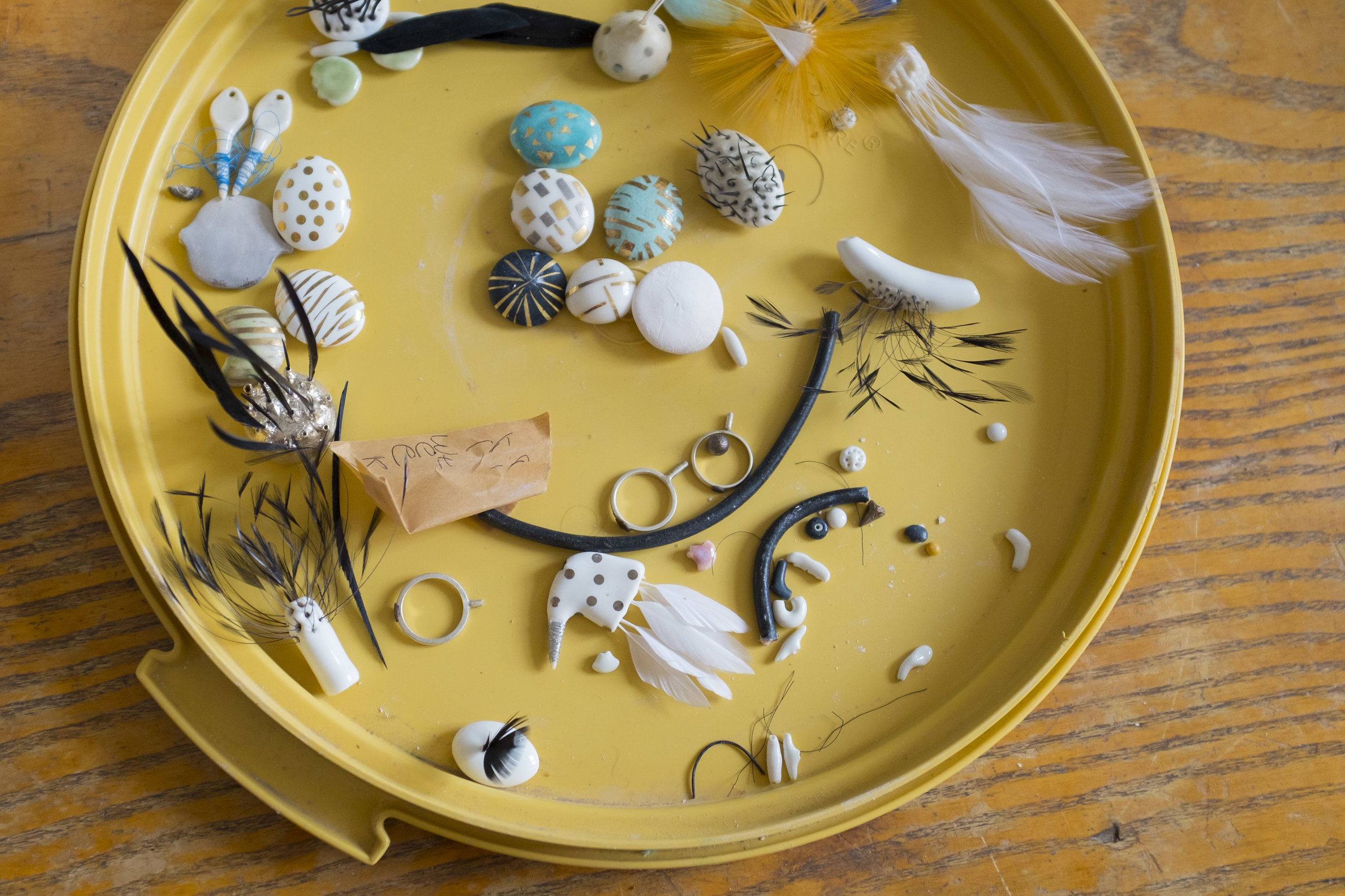
Monty J
Who are you?
Monty J, Brooklyn artist.
What do you make?
Mixed media ceramic sculpture and mixed media jewelry also.
Do you have a preferred medium?
My preferred medium would definitely be clay. I feel like I have a good relationship to clay now. Clay is relatively forgiving, it allows me to go in different directions.
Describe your workspace.
Clayspace is an amazing studio. It's more of a community here than a workspace. It's like a maze; people all know each other and everybody aids each other. It's really cool, I've never been in a studio like this. And I've been in a few. It's very giving and very sharing. Not many secrets. If I ever reached some kind of sustainable success, I would have a private studio but I would always stay in a public space. From just observing I believe that when artists have their own spaces their work generally doesn't change very much. I think that public spaces influence, infringe, and inspire.
Under what conditions do you work best?
Late nights. Anything past ten to four in the morning. I’m on fire. I’m very nocturnal so it just works for me. I’ve been trying to switch that by getting up in the morning to get work done, but the work is different. You can see the subconscious mind blending into the nighttime pieces, but in the daytime it's not the same thing. So ten to four. It’s weird and it’s awesome.
Do you have any rituals surrounding your practice?
Yes. Come in to the studio, be very distracted, eat a few times, wander around, bother other artists, try to get the stress off. I'm very restless so I need to get rid of some energy before I go in; I need to loosen up a little bit. I work better when no one is around. I can work when people are around, and I do, but I like it better when no one is around. It's a kind of juxtaposition between wanting to be in a public space but not wanting to be bothered by other people. It's weird but it's okay.
Describe your creative process.
Ideas are drifting everywhere. I don't necessarily think that ideas come from a person specifically; I think that a person can accept ideas. So if I'm making a vessel with legs, I allow that process to happen and allow images to just come to me. I wish I knew where they were coming from. I don't know where, but they come. So I sit with them, mull the image over, and figure out how innovative it will be and how it will transcend the work or push it further. I've done okay that way. I usually draw down my ideas. I've learnt that lesson. If it's three in the morning and you get an idea, you need to write it down. It feels so good to see something that I’ve never seen before and maybe someone else hasn’t either. But if it only stays in my mind and I go back to sleep, it’s over, it’s gone. In my mind it feels so good to see something that I've never seen before, and maybe someone else hasn't either. But if I go back to sleep, it's over, it's gone.
Describe your creation process.
So once I have a good idea I make sure to draw it down and I try to figure out how to elevate it. I try to get everything done before I start making. This doesn't always work; some of the best pieces have come from planned pieces that did not work or leftover clay from other pieces. I've been blessed and creative enough to be able to fill in the gaps, so if the planned piece works and I have leftover clay, I can usually come up with something else as well.
What's the process of titling your work?
All the planters have female names. I think about women's fashion and the amount of expressiveness that women have. I think that feminine energy is far more expressive. Feminine energy has so many more outlets. I think that male energy is very rigid, it's very structured, and that's good. I mean that's the balance. But the beauty part is definitely female. There's a freedom there and that freedom is powerful. We're in an interesting time now when people are struggling with these things. But it doesn't have to be a struggle. I'm masculine, but I have feminine qualities that I need to express too, so I can express them this way.
What is the most challenging part of your process? Where do you find the most ease?
Let me answer that backwards. The ease is ideas. Like I say, that's the thing about being alive: everybody has ideas, which is good. It's about making those ideas come out and being able to inspire and share them with people. If other people get it, it works. I am not that artist that tries to make something that people don’t get. It’s a dance, right? We’re in this together. I want us to dance, to have a good time. So ideas are easier, but implementing them is very different. That's difficult enough. Back in the day they used to have this stupid sport—for me it's stupid but probably not for someone else—where they used to take these rods and put plates on them. It's plate spinning; they would put the plates on and spin and spin and spin until they'd have ten rods and one person trying to keep all of them going. That's my process right there: plate spinning. Trying to balance all these different things. I love it. It's insane.
What do you hope your work communicates?
As an artist I want the work to meet people. I’m not so interested in people meeting me. The first store my work was sold in was Moicun. People don't remember me from that, they just remember the work, which is good. I’m pretty private, but I definitely want people to form a relationship with the work. Oftentimes you buy something and it just sits around—what's the purpose? If you invest in something I think that it's better when its alive. By blending something alive like a plant with the ceramic work that isn't really alive, that dances.
Does working in New York have an influence on your practice?
Oh yeah. It’s very powerful here. There’s an energy here that makes everyone very restless and I definitely think it affects my work. It kind of galvanizes and focuses. I think there’s some peace in that. I can kind of vanish and not be bothered.
Is there anyone or anything that inspires you?
The inspiration comes from the channeling of ideas. We all want something new, it's what drives us. So just being a part of new things happening is really inspiring. I also love science fiction. I want to find that balance between something alien and something familiar. I’m trying to get at that thin seam. That’s powerful. That’s a rare thing.
How have you learned what you know?
I started clay in kindergarten. I remember that day. I forget all kinds of stuff, but I remember that day. I remember sitting around these tiny tables and the teacher came in and she had a Folgers coffee can. She said, “Today we’re going to play with clay,” and she opened up the can. I remember that oil smell because it was oil-based clay, I think they call it plasticine. We all started making fingernails because it was easy. We'd make our fingernails really skinny and long and we'd play monster hands. Then eventually everybody started making monsters. I remember coming home and telling my mom that I wanted clay. I'm an only child so I didn't have a lot of distractions, and you know how it is, you have to keep a kid busy. So that's where I started. It's been a long journey.
In what ways has your practice evolved over time?
In the beginning I never drew or wrote things down. I would just try to remember, then I'd forget and end up just drifting into whatever would come. I think that's important though, because that drifting kind of trains the mind in a certain direction. Then over time you take some lessons. We always say self-taught, but what is self taught? There's no such thing. Self guided, yes, self taught, no. So you take those lessons and the combination of both the drifting and the structure is powerful.
What has your practice taught you?
That’s a good question. There are no insignificant people. I'm going to make this big and then bring it back. You have seven billion people. There's power with each person. There are a lot of things you can't do, but there are a lot of things that can be profound, even in a very small way. Everybody has something to give. Everybody is also looking for inspiration, they’re looking to share in an experience. So it's important to give people a platform to share. People are afraid of each other for good reason. We play this game like we’re civil—and we do pretty good at the civility game—but I think we need help. And art has always been that help. It evens the playing field. It simplifies our experience. Everybody looks at art, across cultural lines, no matter what kind of nonsense is going on. I think that's so crucial. So there’s nothing insignificant about people or their art.
How has your practice shaped your hands?
Oh man. Rough, wrinkly, dirty nails, cuts—oh man. These won’t be modeling hands, I’ll tell you that. I wish they weren’t so rough and hard all the time. But when you love something your love shapes you. You don’t choose that, it is what it is.
Monty J in Brooklyn, New York on December 2, 2017. Photographs by Julia Girardoni.
